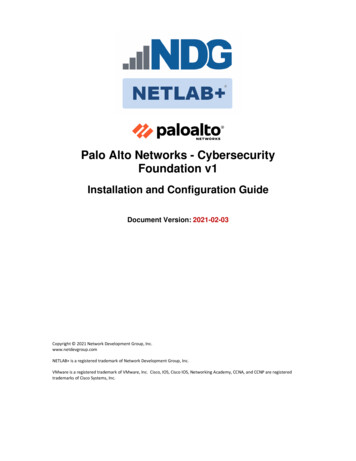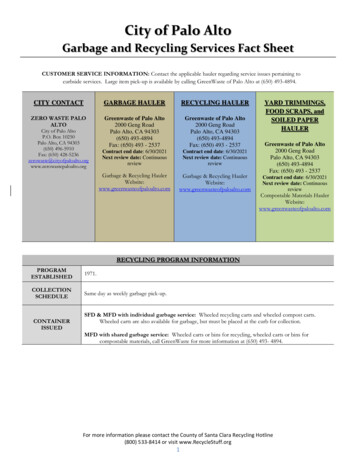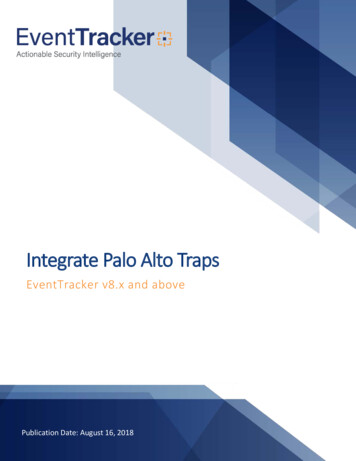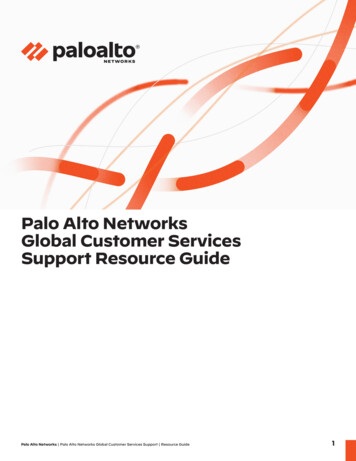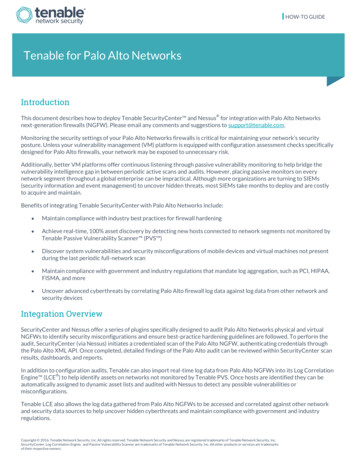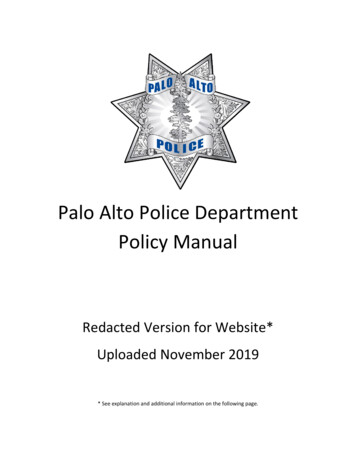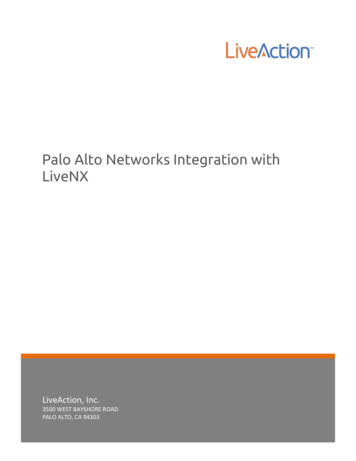
Transcription
PALO ALTO NETWORKS (PANW)SummaryPalo Alto Networks is a cybersecurity firm that is known forselling security appliances, subscriptions, and supportinto enterprises, government entities, and service providers.The company's product portfolio includes firewall appliances,virtual firewalls, endpoint protection, cloud security,and cybersecurity analytics. The Santa Clara, California,firm was established in 2005 and sells its products worldwide.1BUSFIN 7225: Student Investment ManagementFund Manager: Royce WestResearch Analyst: Meghdeep MukherjeeJuly 15th, 2020Company InformationTickerSectorIndustryPrice as of 7/14/2020Market CapShares Outstanding (M)PANWTechnologySoftware - Infrastructure 245.3323.66B98RecommendationInvestment ThesisWe are recommending that investors sell Palo Alto Networks,Inc. due to the following reasons: Current stock price is heavily reliant on Palo Altoshifting to offer a broader suite of Cloud-BasedSubscription and Support offerings; a tacticthe company is still evaluating Post-merger integration has posed challenges forPalo Alto’s leadership, which down the line candilute the gains sought by the acquisitionDiscounted Cash Flow Analysis suggests Palo Alto’sstock price to be overvalued when looking at a tenyear forecast horizonRisksRisks to investing in Palo Alto Networks, Inc. include: Future demand trends for pure-playcybersecurity solutions M&A activity within the cybersecurityindustry, shifting the competitive layout Change in demand due to COVID-19, leadingcustomers to rethink spending prioritiesStock RatingPrice TargetImplied UpsideDividend YieldSell 188.52-23.16%-Key StatisticsRevenue (2019, M)Earnings (2019, M)EPS (2019)P/E (06/29/2020)Beta (5Y Monthly) 2,900( 82)( 0.87)32.331.2Performance History52 Week High52 Week Low1 - Year Return 255.84 125.4722.27%Contact InformationMeghdeep Mukherjeemukherjee.150@osu.edu
Company Overview .3Business Segments .3Products .4Subscription & Support. .5Market Landscape . .5Sector Landscape . .5Competitive Strategy and Market Factors . .6Strategy Shift. . .6Recent Stock News . . .7Investment Thesis. 8Fundamental Drivers. . .8Economic and Sector Conditions. . .9Financial Forecasts . .10Valuation and Price Target. .11Risks. 12Industry Risks. 12Company-Specific Risks. .13Conclusion. .13Appendices. 14Appendix I: Palo Alto Networks, Inc. Product Mix Forecast .14Appendix II: Palo Alto Networks, Inc. Income Statement 15Appendix III: Discounted Cash Flow Model 16Appendix IV: Discounted Cash Flow Model Sensitivity .17References .18PALO ALTO NETWORKS2
Company OverviewPalo Alto Networks, Inc. is a cybersecurity vendor that sells security appliances, subscriptions, andsupport into enterprises, government entities, and service providers. 1 By definition, Palo Alto would beclassified as cyclical company. Having a Beta is 1.2 skews them towards the more volatile side; withperformance trends following the overall economy. Although, most of their product offerings wouldnot fit into the “discretionary” category, some services and products offered by Palo Alto would followmacroeconomic changes. More times than not, customers would consider several of their products tobe non-essential in times of financial distress.Established in 2005, Palo Alto Networks is headquartered in Salta Clara, California. Supporting theirworldwide customer base is a team of 8,049 employees. Palo Alto breaks down their business into thefollowing geographic territories: Americas, EMEA (Europe, Middle East, and Africa), and APAC (AsiaPacific). Being a relatively new company, Palo Alto Networks has established itself as a dominant playerin the Software – Infrastructure industry within the Information Technology sector.2Business SegmentsPalo Alto separates their business into 2 main sections: Product and Subscription. Product Revenue isderived primarily from sales of appliances (including software licenses). Revenue is recognized at thetime of hardware shipment or delivery of software license.2 Subscription and Support Revenue isderived from sales of subscription and support offerings. These contracts last anywhere from 1-5 years.Revenue is recognized over time as the services are performed. 2 As a percentage of total revenue, PaloAlto expects this line to vary from quarter to quarter and increase over the long term as newsubscriptions are introduced, existing subscriptions are renewed, and their installed end-customer baseexpands.2 For the 2019 fiscal year, Subscription and Support ( 1,803MM) made up 62% of the businesswith Products ( 1,096MM) at 38% respectively. The dominance of the Subscription product line isexpected as these offerings are more customizable and typically offer a wide suite of options.Source: Palo Alto Networks 2019 10-K Data; Excel createdPALO ALTO NETWORKS3
ProductAlthough Palo Alto aggregates their offerings into 2 segments when reporting financials, their businesscan be broken down into the following product categories:Secure the Enterprise (Strata)The main product offering in this category is Palo Alto’s famous Firewall; known for its dominance inpreventing attacks with industry-leading intelligent network security. 3 With Innovation andcustomer need in mind, Palo Alto designed their award-winning security featuring the world’s firstML-Powered (Machine Learning) NGFW (Next Generation Firewall).3 Over 85% of the fortune 100 relyon Palo Alto Networks, whose firewalls have been reinventing the industry for nearly 15 years.3Complementing this product is a suite of security management and subscription offerings that delivercustomers a simplified and highly effective network-wide security experience.3Secure the Cloud (Prisma)With Cloud utilization being a focal point for many companies, Palo Alto was able to cultivate a productline for this market. Prisma Cloud, the trademarked name for this segment delivers complete securityacross the development lifecycle of any cloud, enabling customers to develop native applications withconfidence and trust.3 Most commonly used to support AWS (Amazon Web Services) and MicrosoftAzure applications, Prisma’s comprehensive cloud security serves to provide customers fulltransparency, vulnerability risk monitoring, and advanced protection that other cloud offerings lack.Secure the Future (Cortex)Data mining and predictive modeling is the present and future for corporations that desire to useadvanced analytics to accompany their decision-making process. Similarly, Palo Alto’s Cortex productsoffer the industry’s most comprehensive suite for security operations; empowering enterprises withthe best-in-class detection, investigation, automation, and response capabilities without the need ofhuman interference.3 With 50x reduction in alert volume, 8x faster investigations, and 95% automatedresponse Cortex is a superior product that checks many boxes for a large customer base.Source: https://www.paloaltonetworks.com/PALO ALTO NETWORKS4
Subscription and SupportAll products produced by Palo Alto Networks offers (see page 4) an accompanying support package.From Threat Prevention Subscriptions to DNS (Domain Name System) Security Subscriptions andeverything in between, all these ancillary add-ons can be bought on a per-user, per-endpoint, orcapacity-based basis as deemed fit by the consumer.2 If customers experience product malfunctions,Palo Alto expedites replacement parts for any defective hardware with the use of a third-party logisticsprovider that manages their worldwide deployment.2Customer support is also a critical part of Palo Alto Networks’ value proposition. Their authorizedSupport Center (“ASC”) deliver level-one and level-two support, while level-three support is available24 hours a day, seven days a week through regional support centers that are located worldwide.2Additionally, Palo Alto offers annual subscription-based Service Account Management (“SAM”) whichprovides support for customers with custom tailored products.2 This service includes both hardwareand software maintenance which can be purchased for a one-year or longer term at the time of saleand typically renew for successive one-year or longer periods.2Market LandscapeSector LandscapeThe COVID-19 pandemic has had tremendous the impact on the stock market. Year-to-date the S&P500 is down -0.23%.4 Concurrently, over the same time period, the Information Technology sector is up 18.01%.5 Taking the state of the pandemic and the overall health of the economy into consideration,the current perspective is that the market is in a recession. However, if this sentiment holds true, theInformation Technology sector is not performing in line with expectations of the current stage in thebusiness cycle. Historically, the Information Technology sector has consistently underperformed in thelate and recession stages with positive returns occurring in the early and middle stages on the businesscycle.6 Today’s environment not a reflection of history as the Information Technology sector has beenthe primary catalyst in driving market returns.Source: https://eresearch.fidelity.com/eresearch/markets sectors/sectors/sectors in market.jhtml?tab learn§or 45PALO ALTO NETWORKS5
Competitive Strategy and Market FactorsPalo Alto Networks has been able to assert its dominance in the Security Appliance market, coming insecond terms of market share (13.4%, Q4 2019), only behind CISCO (15.8%, Q4, 2019).7 This sustainedcompetitive advantage has been achieved through their ability to engineer a superior firewall productwith industry leading performance and machine learning components that can proactively identifythreats and provide end-customers corrective measures to prevent data theft. Additionally, Palo Alto’srobust product support offering has helped elevate their brand and has kept consumer satisfaction highover the years. The company is well positioned to continue their growth as the trends being utilized inthis industry is already embedded in Palo Alto’s existing product line.Source: /With the firewall market projected to growth on average of 12% per year through 2023, success in thisspace will be determined not on physical hardware firewalls, but more so on software-definedfirewalls.8 Given the impact COVID has had on companies, the investment in data security is a priorityfor all parties that have shifted to a work-from-home dynamic. Companies are investing more in datasecurity upfront to avoid breach litigations in the future. This shift in work environment has forcedcybersecurity firms like Palo Alto to have a greater presence in the cloud space. Since more endcustomers are deploying their systems to the public and hybrid clouds, increased spending in Networksecurity and the firewall market will follow.8Strategy ShiftPalo Alto Networks has recognized that future success is dependent of their ability to bolster the Cloudproduct offering. To achieve this goal, Palo Alto completed the acquisition of CloudGenix back in Aprilof this year.9 As the industry continues to undergo network and security transformations, this move willallow Palo Alto to integrate CloudGenix’s platform into their best-in-class SASE (Security Access ServiceEdge) offering.9 Specifically, with ClouldGenix’s cloud-managed SD-WAN (Software-defined Wide AreaNetwork) solutions, Palo Alto can expedite the onboarding of remote branches and retail stores intotheir existing Prisma product line; allowing for a more seamless and efficient transfer from SD-WAN toSASE for their existing customer base. 9 Although post-merger integration has been a challenge for PaloAlto in the past, this acquisition, if handled correctly, will make Palo Alto Networks a formidable forcefor quite a long time.PALO ALTO NETWORKS6
Recent Stock NewsThe illustration below from Palo Alto Network’s 2019 annual report depicts the five-year return of PaloAlto compared to the NYSE Composite Index and the NYSE Area Tech 100 Index. Palo Alto hasoutperformed both indices over this time period as their consistent top-line growth has fueled investorconfidence. The 2018 and 2019 calendar year was favorable to Palo Alto due to the optimism thatsurrounded the overall economy; driving much of the stock market returns.Source: 2019 Palo Alto Networks Annual ReportOn May 21, 2020 Palo Alto Networks released their fiscal third quarter results. Quarter three revenuegrew twenty percent year-over-year ( 869.4MM versus 726.6MM).10 Billings (revenue plus the changein deferred revenue12) increased twenty-four percent ( 1B) year-over-year, along with deferredrevenue, which grew twenty-eight percent ( 3.4B) year-over-year.10 Net losses for the third quarter2020 was 74.8MM, which amounts to be 0.77 per diluted share as compared to a net loss of 20.2MMor 0.21 per diluted share for the third quarter of 2019.10 Surpassing quarter estimates can beattributed to remote working models that are being carried out by companies to promote socialdistancing measures and stop the spread of the coronavirus. Palo Alto Networks CEO Nikesh Arorastates: “The world will likely be in a state of transition over the next 12 to 18 months due to COVID-19pandemic”.11 He goes on to state how this environment will prompt key trends to accelerate, includinga rapid shift to the cloud and focus around AI/ML and automation to drive cybersecurity outcomes.11For fiscal fourth quarter, Palo Alto Networks upped their guidance. The company is projecting a nonGAAP earnings between 1.37 to 1.40 with revenue expectations falling anywhere between 915 and 925 million.10 If these projections are accurate, Palo Alto would surpass expectations as analysts arelooking for a non-GAAP earnings of 1.31 with a revenue of 916.8 million.11 For the fiscal year 2020,Palo Alto Networks is projecting revenue estimates to be between 3.37 billion and 3.38 billion with anon-GAAP earnings per share coming in somewhere between 4.78 and 4.81.10PALO ALTO NETWORKS7
Investment ThesisFundamental DriversThere are three main drivers that will determine Palo Alto Network’s outlook moving forward, few ofwhich are all speculations at this point. First, sixty-two percent of Palo Alto’s 2019 revenue was drivenby their Subscription Product line. A large part of their future performance is contingent on thecontinued success of this product offering. Second, with market conditions and demand constantlychanging, Palo Alto’s Next Generation Firewall performance and specifications will have to meet therequirements of their broad customer base. Lastly, with COVID-19 pandemic still plaguing theeconomy, the demand for Cloud-Based Services will drive much of Palo Alto’s future performance asmore and more companies will make a push to have robust network security measures to keepconfidential data safe. The current outlook for Palo Alto Networks looks uncertain, and should bereflected in the stock price. Conversely, investors are betting that Palo Alto’s strong top-line growth willbe enough to sustain their momentum, which is artificially inflating the current stock price.Subscription Product LineOver the last four years, Palo Alto’s Subscription and Support product line has made up roughly fifty-sixpercent of revenue. Given how COVID-19 has impacted the economy, the demand for cybersecurityprotection will continue to stay top of mind for the next couple of months/years. As enterprises lookbolster up their remote security measures to accommodate the shelter-in-place guidelines, Palo AltoNetworks has a prime opportunity to capitalize on these market conditions. Furthermore, as thesesubscriptions generally last anywhere from one to five years, a steady cash flows stream can beexpected from this product line. On the contrary, given the intense level of competition in this sector,Palo Alto will have to effectively find ways to promote their Subscriptions over their competitors as thecompanies producing similar products will try and capture market share. The Subscription and Supportline has provided great returns in the past for Palo Alto, and given their current product offering,revenue growth for this line does not seem to be slowing down anytime soon.Next Generation FirewallOver the years, Palo Alto Networks has found ways to stay ahead of the curve from an innovationstandpoint. Most recently, they released the world’s first ML-Powered (Machine Learning) NGFW(Next Generation Firewall).3 As product differentiation is key in this sector, Palo Alto Networks thus farhas been able to strike a good balance between innovation and performance. However, even with theutilization of cutting-edge technology, Firewall sales make up only forty-four percent of their totalrevenue. The future growth of this product line will be largely dependent of how well the overalleconomy does. As entities find ways to combat COVID-19, the need or desire to upgrade existingfirewall systems may not be a priority for most companies. This effect can already be seen whenlooking at the year-over-year product growth. For fiscal quarter three, compared to the previous year,Product revenue was up one percent while Subscription and Support grew more than thirty-onepercent.12 Even with Research and Development in the heart of their decision making process, Palo AltoNetworks will have its fair share of challenges maintaining historical growth rates for the Productbusiness segment given the toll COVID-19 has taken on the global economy.PALO ALTO NETWORKS8
Demand for Cloud-Based ServicesPalo Alto Networks is relatively new in the Cloud Service space, but like their competition they haverealized the tremendous upside this market possesses. This is a space where Palo Alto has investedsignificant amount of capital via the acquisition (CloudGenix) channel in hopes to be a prominent playerfor the imminent future. As threat-prevention is a key focus for many companies today, Palo Alto hashigh growth potential with room for improved margins in this niche segment.12 As companies deal withmore data traffic coming from various entry points (remote work locations), the need for consolidatedsecurity management is on the rise.12 This plays well into one of Palo Alto Network’s core competency;centralized security management.12 One factor that is key to the growth of this segment is post-mergerintegration. How well Palo Alto Networks can utilize the synergies from CloudGenix, will come down totheir ability to synchronize the operations of both entities. Overall, this product line has theopportunity for sustained growth, but will largely be dependent of the success of their current andfuture acquisitions in this division.Economic and Sector ConditionsThe Information Technology sector has been able to sustain positive returns throughout the COVID-19pandemic. However, there may be a sense of overvaluation in the sector. Typically, during the last 2phases of the business cycle (Late and Recession), where the economy moderates or contracts, InfoTech underperforms. Nevertheless, this year, the Information Technology sector is seeing valuationsbeing close to an all-time high compared to the S&P 500. The current P/E multiple for Info Tech is37.4813 versus 27.9514 for the S&P 500. The concern arises when the current Information TechnologyP/E multiple is compared to the median for the sector (37.48 and 18.9 respectively). The large deltabetween the two figures raises the flag for a potential correction. This leaves the short-term outlook forthe sector to be somewhat unclear as markets try navigate through the COVID-19 pandemic.A positive for the Information Technology sector has been the shelter-in-place order. As companiesswitch to working remote, industries such as data security, cloud initiatives, and virtual meetingapplications to name a few have seen a spike in cash infusion. The current secular trends are in favor ofthe Information Technology sector, and the long term future outlook seems to be on pace to breakhistorical expectations.Sector ValuationAbsolute rce: Assignment 2 SIM Class, Summer 2020 (Data as of May, 2020)PALO ALTO NETWORKS9
Financial ForecastsOver the last 12 months, Palo Alto Networks has seen roughly a twenty-two percent increase in itsstock price. Comparing their performance to the Information Technology sector and the S&P 500(36.72% and 8.84% respectively), Palo Alto outperformed the S&P 500 as whole, but lagged well behindthe Information Technology sector during this period. Much of their 2020 performance can beattributed to the state of the pandemic, as investors favored Info Tech to carry the market through thefirst half of the year. Shelter-in-place orders further drove up Palo Alto’s price as investors grewoptimistic around companies that played in the data security space. Fiscal quarter three revenue grewtwenty percent year-over-year, with the quarter four estimates forecasted to beat analyst expectations( 1.41 EPS versus expectation of 1.31 EPS).Source: Yahoo Finance: historical monthly data pullAlthough Palo Alto Networks has experienced modest gains this year, their performance has beenaverage compared to the competition. Palo Alto Networks’ returns have been similar to companies likeCISCO and Norton LifeLock. However, when looking Net Income, Palo Alto Networks rank the lowestamongst their competitors. Taking Palo Alto’s performance relative to its peers, it’s clear that theirstock price is based more on speculation versus actual results.TotalReturn 1 ONLIFELOCK INC.NLOK-O(18.70%)CISCO SYSTEMS, INC.CSCO-OCYBERARK SOFTWARE LTD.CYBR-O(28.13%)NameTickerPALO ALTO NETWORKS, INC.PANW-USFORTINET, INC.Net IncomeTTMEPSTTMP/ETTM(228.90) ) 03Source: Thompson One, PANW CompsPALO ALTO NETWORKS10
Our projected income statement for Palo Alto Networks is shown in Appendix II. Our future outlook isbased on the Subscription and Support segment driving majority of the sales volume with marginscoming in slightly higher than the Product segment.We expect Product revenues to decline 3% for 2020, grow 10% and 14% respectively for 2021 and2022. In the Subscription and Support segment, we are forecasting a 28% growth for 2020, 20% growthfor 2021, and a 21% percent growth for 2022. The expectation around gross margin for both of thesesegments are moderately conservative with Product gross margin improving to 75% from 71%, andSubscription and Support gross margin climbing to 77% from 73%. However, even with strong growthand improved gross margins, our belief is that operating margins will be in the -1% to -3% range overthe next three years.Valuation and Price TargetStarting with the Discounted Cash Flow Model (DCF), we utilized the Income Statement found inAppendix II to bake in the effects of Subscription and Support revenues outpacing Product revenues forthe foreseeable future. Taking into account the current state of the pandemic, we are projecting that2022 will be the first year Palo Alto Networks can capitalize on their investment in Cloud-basedsubscriptions to drive more recurring revenue, with the assumption that longer contract terms will bereached with end-customers. Based on these factors, we expect 2022 and 2023 revenue growth toreach 18%, followed by a marginal drop in growth rate between 2024 to 2028, and the final terminalgrowth rate of 6% being achieved by 2029. Additionally, we assumed operating income will increase to7% by 2021 and level off for the years that follow. Taking all these factors into account, and using a10.25% discount rate, the DCF Model projects Palo Alto Network’s equity value to be 17.2 billion.Using a basis of 98 million shares outstanding, the implied equity value/share of Palo Alto is currently 175.52. Comparing this to their current share price of 245.33, the DCF Model suggests anovervaluation of the current stock price by 28.5%.Another method explored to gauge Palo Alto’s valuation was the Comparisons Model (COMPS). Westacked up Palo Alto with its closest 4 competitors: Fortinet (FTNT-O), Norton LifeLock (NLOK-O), CISCOSystems (CSCO-O), and Cyberark Software (CYBR-O). Comparing these 5 companies, it is evident thatPalo Alto is under the average for both P/E, P/S, and P/B, but significantly over average on EV/EBITDA.NameTickerPALO ALTO NETWORKS, INC. PANW-USP/EP/SP/B EV/EBITDANEG 7.1225.4671.9062.03 9.3830.6743.403.33 4.77 1,077.1513.45FORTINET, INC.FTNT-ONORTONLIFELOCK INC.NLOK-OCISCO SYSTEMS, INC.CSCO-O16.89 3.835.0310.75CYBERARK SOFTWARE LTD.CYBR-O78.84 9.105.0349.1140.27 6.84228.6737.72AverageSource: Thompson One, PANW CompsApplying these ratios to Palo Alto, the range of share prices that can be derived falls anywhere from 147.50 (based on a target EV/EBITDA multiple of 43.23) to 281.25 (based on a P/B target multiple ofPALO ALTO NETWORKS11
30.1). To get a better pulse on Palo Alto’s valuation, we combined the DCF Model with the marketmultiples to create a weighted model. Here, the DCF was assigned a 70% weighting, both the P/E andEV/EBITDA were assigned a 10%, and the remaining 10% was split evenly between P/S and P/B. Usingthe combination of the DCF Model and the Weighted price multiples, we priced Palo Alto Network’sstock at 188.52. The valuation metrics, price targets, and weightings are outlined in the table below.Valuation MetricDCFP/E RatioP/S RatioP/B RatioEV/EBITDAFinal Target Price:Weight Price Target70% 175.5210% 245.085% 237.935% 289.9910% 147.50 188.52RisksIndustry RisksThe COVID-19 pandemic is the biggest risk that every industry and company is dealing with right now.With new cases per day still climbing to record highs, the future outlook for not only the InformationTechnology sector but the economy as a whole is uncertain. Even with the two trillion-dollar aidpackage put out by the government15, the list of companies going bankrupt keeps on getting longer.The volatility that can been seen in the market is an accurate representation of how uncertain investorsare on the future outlook of the economy. Although the Information Technology sector has done wellthis year, one thing these market conditions have taught us, is that historical trends are not necessarilya predictor for future results.In addition to the overall uncertainty that exists in the market, the cybersecurity industry is constantlychanging because of ever-evolving threats.12 As more companies move data over to Cloudenvironments relying on SaaS (Software as a Service) applications, the demand for pure-playcybersecurity solutions will go down.12 Specifically, entities choosing to go down the SaaS route, canrely on security through the means of insurance provided by SaaS vendors.12 If the popularity ofapplication based security rises, the barriers of entry into this marketplace is reduced, essentiallyleading to an increase in the number of startups that will crowd this industry.Lastly, with competition being fierce in the cybersecurity market, the product offerings available toconsumers are quite similar. Additionally, every company that operates in this space is chasing thesame business model; to create a consolidated security platform. At the end of the day, if all thesesolutions are comparable, then the only differentiator will be price. A price driven market is a win forconsumers, but comes at a cost to the producers. Over time, M&As would dominate the market, assmaller scale companies would get bought out by prominent players. In today’s environment, productsare priced based on how much capital is being invested in research and development initiatives tofurther innovation. If larger players start under-cutting new entrants or smaller producers, not only willthere be limited vendors playing in this space, but the room for product differentiation would be non-PALO ALTO NETWORKS12
existent. The end result would be a contest to offer the lowest price rather than competing on productspecifications.Company-Specific RisksPalo Alto Networks has some debt position issues that could be a problem down the line. As ofDecember 2019, the company has a net cash position of 1.37B. (2.8B total cash and ST Investments - LTdebt of 1.43). Their total liability is roughly 5B; 2B of which is due within a year, and 3B due at a laterpoint.16 All of this amounts to Palo Alto carrying about 1.7B more liability (3.3B – 5B - 1.7B) than cash receivables.16 Although not overly concerning, Palo Alto Networks should consider the right balanceof cash and debt as they look for potential ways to bolster their balance sheet. Additionally, there areconcerns around Palo Alto’s ability to reduce spending as a percentage of revenue while maintaininggrowth.12 Historically, Palo Alto has generously rewarded employees with stock options, and divertingfrom this route could have a negative impact
Summary Palo Alto Networks is a cybersecurity firm that is known for . preventing attacks with industry-leading intelligent network security.3 With Innovation and . outperformed both indices over this time period as their consistent top-line growth has fueled investor confidence. The 2018 and 2019 calendar year was favorable to Palo Alto .
